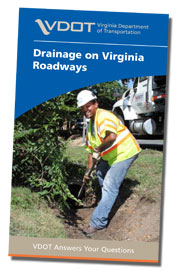Drainage on Virginia's Roads
See the news release
Good Drainage: It's What Keeps Virginia Roads Safe When It's Wet Outside >>
Drainage of stormwater away from travel lanes keeps roadways safe and helps to protect Virginia’s investment in its transportation network.
Poor drainage and standing water can make vehicles hydroplane and cause premature pavement deterioration.
Consequently, VDOT works to maintain the flow of stormwater off the pavement and through the right-of-way of state-maintained roads. Maintaining drainage facilities is an important part of the mission of VDOT.
What are drainage facilities?
Drainage facilities can include:
- Open channels and ditches (paved and unpaved)
- Underdrains
- Culverts
- Gutters
- Catch basins
- Drop inlets
- Manholes
- Storm sewer pipes
- Stormwater management facilities
A drainage system can include both public and private facilities.
Some systems are maintained by VDOT, while others are maintained by public bodies, such as a city or county, or private property owners and homeowner’s associations.
How does VDOT maintain drainage facilities on its roads?
At VDOT, we:
- Remove soil buildup and debris from open channels, ditches, and gutters.
- Clean out inlets, catch basins, storm sewer pipes and culverts.
- Replace structurally deficient or damaged storm sewer pipes and culverts.
- Perform annual inspections on stormwater management facilities and perform necessary corrective actions.
What drainage facilities does VDOT maintain?
VDOT maintains drainage facilities located on state operated roadways or within state-owned right-of-way.
Occasionally, VDOT will need to acquire access to additional land beyond the state owned right-of-way to ensure proper drainage for the roadway facility. This access is typically in the form of a permanent drainage easement.
When an easement is recorded in VDOT’s name, VDOT accepts drainage maintenance responsibility for this area.
What are the drainage responsibilities outside of VDOT right-of-way and easements?
Other entities may also acquire property easements to resolve drainage concerns in a specific area. 
Click for brochure
These drainage easements are dedicated to that entity, which could be a city, a county, a homeowner’s association or another party.
These entities are responsible for maintaining their drainage facilities in these easements.
VDOT will only maintain drainage facilities in these easements when obstructions create problems within the roadway right-of-way.
I am a private property owner. What are my drainage responsibilities?
- Avoid any activity that prevents the free flow of water, such as placing grass clippings, leaves and debris in an open channel, ditch, driveway pipe, or in any location that will block the free flow of stormwater runoff.
- Conduct activities on your property in a manner that prevents the discharge of pollutants, including pet waste and fertilizers, into the drainage system.
- Property owners are responsible for the maintenance of drainage facilities on their private property when the facilities are not part of a VDOT-owned drainage easement or a county or city easement. In these cases, property owners must take responsibility to keep stormwater free-flowing through their drainage facilities.
- Property owners may not obstruct the flow of stormwater to the detriment of another property owner.
What can I do if I have standing water in my ditches?
See if there is anything you can do to get the water draining properly. It could be as simple as removing grass, leaves and other materials that are blocking drainage pipes or inlets.
In the tidal areas of Virginia, standing water may appear and disappear in open channels along a road throughout the day according to the region’s tide schedule. This is a sign that the ditch is functioning properly and doing its job to drain tidal waters away from the roadway.
What if the problem continues after I have removed debris?
Call VDOT’s Customer Service Center at 1-800-FOR-ROAD (800-367-7623) to report a drainage concern. VDOT will research your specific inquiry and determine if the agency has responsibility over the concern.
I have standing water in my yard or flooding at my residence. Can VDOT help?
VDOT can respond to reports of flooding or standing water only when it affects a state-maintained roadway or state right-of-way property.
Consequently, VDOT does not maintain or install drainage facilities on private property.
VDOT’s mission is to provide for safe travel on state-maintained roadways and to protect their condition. VDOT maintains drainage facilities for these two reasons.
What if I discover polluted stormwater in a VDOT roadway drainage facility?
VDOT’s stormwater drainage system can often become contaminated with illegal discharges from showers, washing machines, failing septic systems or other sources of pollution.
Call VDOT’s Customer Service Center at 1-800-367-7623 (800-FOR-ROAD) to report a polluted stormwater concern.
VDOT will research your specific inquiry and determine if the agency or other agencies or jurisdictions have responsibility over the concern.
I own a business and the drainage facility at my commercial entrance needs repair. Can VDOT fix it or replace it?
Landowners are responsible for repairing or replacing drainage structures on private property.
Property owners must make the repair or replacement in a timely manner.
A VDOT permit is required before any work can be performed that affects a state-maintained road. Contact the VDOT Customer Service Center at 1-800-FOR-ROAD (800-367-7623) to be connected with your area office to begin the permit process.
What state or federal laws outline drainage responsibilities?
State drainage laws are primarily based upon civil law rules, a system of laws based on prior court decisions.
These rules place a natural easement on the lower land for the drainage of surface water to its natural course. The natural flow of water cannot be obstructed by the servient owner to the detriment of the dominant owner.
Regulations that may apply to VDOT drainage easements can also be found in the Virginia Administrative Code and various VDOT policy manuals.



